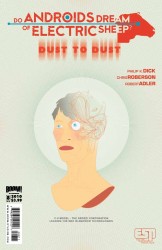![]()
Do Androids Dream of Electric Sheep?: Dust to Dust is a prequel to the sci-fi classic by Philip K. Dick and attempts to answer some lingering questions left open by the original. Does this new story reach the same heights as the original? Read ahead to find out.
 DO ANDROIDS DREAM OF ELECTRIC SHEEP?: DUST TO DUST #8
DO ANDROIDS DREAM OF ELECTRIC SHEEP?: DUST TO DUST #8
Writer: Chris Roberson
Art: Robert Adler
Colors: Andres Lozano and Javier Suppa
Letters: Comicscraft’s Jimmy Betancourt
Cover: Connor Willumsen
Editor: Bryce Carlson
Publisher: Boom! Studios
Price: $3.99
Previously in Do Androids Dream of Electric Sheep?: Dust to Dust: The renegade group of androids have been located by Charles Victor, an android tasked with retiring any machine that goes against its programming. Will their battle save or condemn the human race? This final chapter in the prequel to Do Androids Dream of Electric Sheep? will answer some nagging questions and fill in the blanks of Philip K. Dick’s sci-fi masterpiece.
A Simple Story With Huge Expectations
One of the most surprising aspects of this mini-series is how it doesn’t concern itself with telling the story of a young Rick Deckard and how he got involved with hunting replicants and it also doesn’t distract readers with constant nods and “easter eggs” for fans of the original. Instead this book really tries to stand on its own and tell a completely different story than Dick’s original all while keeping its tone and spirit alive.
This final issue in the series ties everything up neatly with a whole lot of gunplay and some dead androids. While the pacing and writing style of Dick and Roberson differ quite a bit, the tone and spirit of the original is kept firmly intact in this prequel. Roberson deals with the same questions on life and emotion that Dick wrestled with in his original and he even presents some interesting theories and questions of his own. This book is at its best when it centers on Malcolm Reed and his inability to cope with his own emotions and the emotions of anyone around him. Reed seems to take solace in the emotionless company of androids. But while Malcolm Reed may be the most interesting character in the book, he takes a back seat to a clichéd third act ripe with explosions and violence.
Throughout the series, Roberson has done an admirable job of replicating the best parts of Dick’s original all while trying to stand on his own two feet. While he succeeds in covering some of the same ground that the original did, it never feels like he blazes new trails. His detective story is nice, some of his thoughts on emotions are truly thought-provoking and his take on Dick’s world is very accurate to the original. But it never feels like this prequel is vital to the original. The job of a prequel is to stand on its own as a story and to also enrich the original. While this story does stand on its own, it is does not have any effect on the original.
Art That Lives In The Shadow Of Its Predecessor
When Blade Runner hit theaters, one of the most impressive aspects of it were the visuals. Dizzying skyscrapers, luminous cities and futuristic vehicles that buzzed around like dragonflies all populated Ridley Scott’s world and it dazzled audiences. While this prequel is set before that time, Robert Adler’s art never reaches the breathtaking levels that Blade Runner did.
Adler’s character work is very well rendered and Malcolm Reed’s panic and mental anguish is portrayed brilliantly, but there is never a sense of size in the book. Most of the panels are close up shots on faces and people that never give a sense of place. Adler never pulls back to show a city bereft by illness and war. His panels of a rundown apartment building look great and his characters always seem full of life (even the androids) but it just seems to be lacking any of the visual flair that was present Blade Runner. And while these comparisons may not be fair they are inevitable when tackling a story that is so beloved.
Bottom Line: Pick It Up If You’re A Fan
While this prequel never fails on a Jar Jar level, it never quite improves upon, or even rivals, the original either. There are some interesting ideas and thoughts about human emotion and life, but there just isn’t enough to really make this work. The biggest complaint about this book is that it is a prequel that isn’t required reading if you have already read the original. It just doesn’t add enough to the original to really recommend it unless you are a ravenous Dick fan…. boy I probably could have worded that better.




1 Comment
I really really hate that cover to the comic, more than any cover that I’ve seen in a long time.